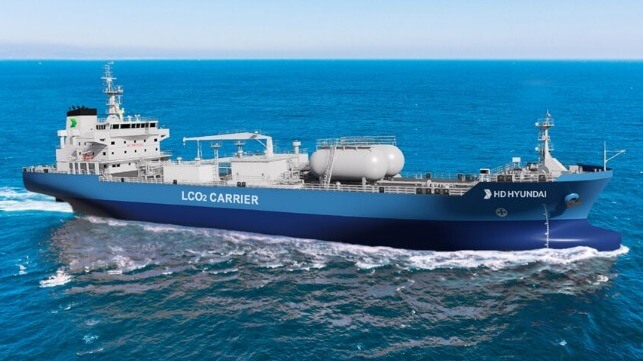Work Begins in South Korea to Build First Large LCO2 Carriers

HD Hyundai Mipo kicked off its first building program for the emerging market of gas carriers to transport captured CO2. In addition to being the first LCO2 carrier to be built in South Korea, the vessel is significantly larger than the ones currently being built in China. Hyundai anticipates that it is an emerging market that can leverage its expertise in gas carriers.
Steel cutting began at the group’s Ulsan shipyard for the first of four LCO2 carriers ordered by Greece’s Capital Maritime Group. The first two vessels were ordered in July 2023 but Capital expanded the order before construction ever began based on the anticipated strong demand for carbon transport as part of the planned capture and storage options.
Hyundai highlights unique challenges for this segment which it has been able to address by advancing the pressure control technology of liquified gas. Working with its affiliate shipyards in the HD Hyundai Group, the Mipo shipyard reports it completed development of the new pressure controls in April.
“We are further accelerating the development of new ship technologies and the expansion of production facilities in preparation for increasingly strengthened decarbonization regulations,” said an official of HD Hyundai Mipo during the ceremony marking the first steel cut.
The vessels will have three “Bi-lobe type carbon dioxide storage tanks” with a total capacity of 22,000 cbm. By comparison, the vessels being built in China for Norway’s Northern Lights project each have a capacity of 7,500 cbm. Hyundai highlights that the tanks can stably maintain a low temperature and a high-pressure environment of -55 degrees C, five times normal atmospheric pressure. The control system is vital because if the pressure in the cargo hold decreases, the liquid carbon dioxide may change into a solid form of dry ice, which would damage the piping and other systems.
The pressure control system also will permit the vessels to be versatile in their cargo. It will be possible to also transport liquefied petroleum gas (LPG) or ammonia in addition to the LCO2.
Each of the vessels will measure approximately 525 feet (159.9 meters). The hull is also ice resistant (Ice Class 1C) so that it can navigate safely in cold, icy seas. HD Hyundai Mipo reports the vessels will also have 2,500 kW shore power units and SCR nitrogen oxide reduction devices on their exhaust. The design is also ammonia ready meaning with future modifications the vessel could be fueled with ammonia.
Capital Gas reported in June that it signed a letter of intent to install a pioneering onboard carbon capture system also on these vessels. The system is being designed by a Greek company, EMRA First. Both Lloyd’s Register and DNV reviewed the design concepts for the CO2 capture system.
The first of the vessels is scheduled for delivery to Capital Gas in November 2025. The three additional vessels will be built sequentially with deliveries scheduled to continue to the second half of 2026.
